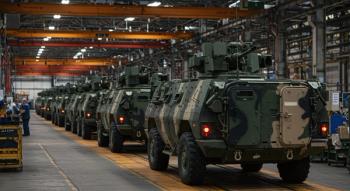
Optics and Lasers Wavelength
Optics and Lasers Wavelength
Advances in the field of optics have a big impact on spectroscopy. This month's Technology Forum focuses on optics and lasers, fundamental components of spectroscopic techniques. Participants in this discussion are Robert Messerschmidt, Spectrum Scientifics, and Rob Morris, Ocean Optics.
Which optical components form the heart of a spectrometer? What do you think is the current state of these optical technologies?
(Messerschmidt) Fundamentally, an optical spectrometer requires a source and a detector of a given range of wavelengths of radiation, and a means of telling those wavelengths apart. The radiation interacts with a sample in a sample chamber. The method and means of interaction with the sample is where things get interesting. Sampling methods include transmission, external reflection and internal reflection. I would say that the sampling device is at the heart of the spectrometer, especially since it is transplantable. Almost every component of a modern spectrometer is better and/or less expensive today than it was 10 years ago. I see no reason for this trend not to continue.
(Morris) Essentially, there are four main parts of a spectrometer: the detector, electronics, the grating, and other optics (focusing and imaging mirrors, etc.). Detectors are becoming faster, smaller and better performing, especially linear CCD arrays. One advance in electronics is the addition of functionality at the board level - things like storing spectrometer calibration coefficients on the board, more I/O lines and so on.
Gratings haven't changed much in the last decade. There is some movement toward filter-based spectrometers, which would use optical filters in place of gratings to separate orders of light.
The other optics in the spectrometer add lots of functionality for the user - things like bandpass filters, UV transmission filters, Ag-coated mirrors for low light level applications, and so on. These optics have made miniature spectrometers, in particular, able to compare favorably to higher-priced spectrometers in performance.
In the future, which cutting-edge optics and laser technologies will find applications in spectroscopy techniques?
(Messerschmidt) Smaller, faster spectrometers, deployed in more locations, that function better for a specific application pretty much describe the future of optical spectroscopy. Optics and laser technologies that enable these goals will find ready application. Multiplexing of wavelengths has been a way of getting more information faster for nearly four decades. Nanotechnology will provide new ways of exploiting these multiplex advantages. Equally important will be the use of "just enough" wavelengths to get the job done. In this regard, new tools and methods for making optical filters may become more important.
(Morris) One of the more interesting recent developments is laser-induced breakdown spectroscopy (LIBS), which marries laser technologies and spectroscopy technologies for a different way of looking at analytes. In LIBS, a high-intensity, pulsed laser beam is focused on the sample area, positioned a few centimeters to a meter from the sample. Then the laser is fired and the high-temperature of the laser creates plasma. As the plasma decays, or cools (~1.0 µsec after the laser pulse), excited atoms in the plasma emit light of characteristic wavelengths distinct to the element. All elements emit in the 200-980 nm region.
Do you think new optics/lasers will lead to significant advances in specific areas of spectroscopy? Which ones?
(Messerschmidt) Twenty years ago, tunable lasers were going to revolutionize the practice of mid-infrared spectroscopy. While we are waiting, broadband sources continue to be the workhorses of (linear) optical spectroscopy. Spectroscopists mostly live in a broadband world, and therefore broadband sources seem appropriate. There are many exceptions of course. Raman spectroscopy is irksome without lasers. With lasers, it is less so. Far infrared spectroscopy is starting to be influenced by lasers.
In the area of optical components, few things have had as big an impact on spectroscopy as fiber optics. As practitioners of spectroscopy, we have benefited from developments that have mainly been driven by the communications market. Unfortunately, these markets have no need for mid-infrared fibers yet.
(Morris) With LIBS in particular, smaller and less unwieldy lasers will make the technology more affordable and portable. Now, a LIBS system costs about $50,000 including the laser, and isn't exactly portable at 13 kg. However, we're not too far away from a man-portable LIBS system, which could be used by first responders for applications like explosives detection and chemical and biological warfare agent detection.
Are there any spectroscopy methods whose growth in the near future would boost R&D in optics/lasers?
(Messerschmidt) In order to drive R&D of devices like lasers or optical detectors, the market potential must be quite large. In general, spectroscopy markets are not big enough to drive the development of devices. One notable exception is the medical diagnostic marketplace. Here, billion dollar market opportunities allow for the development of custom components.
(Morris) Spectroscopy and optics/laser technology are very intimately connected, so that any advance has an impact across the board. Development of femto-second speed spectrometers would let spectroscopists measure very transient laser pulses and events, for example.
Which areas of optics/lasers useful in spectroscopy need more industry and academic research focus right now?
(Messerschmidt) Optical materials for mid-infrared spectroscopy have for years limited the broader application of the technique. In a cruel irony, the same fact that makes mid-infrared spectroscopy a virtually universal technique also makes it difficult to find good optical materials: everything has absorption features. Materials that do not are expensive and difficult to work with, and are often referred to as "exotic" in the world of optical fabrication. While chemical vapor deposition (CVD) has helped some, even these materials are still way too expensive for the mass market.
(Morris) Lasers that enable new applications in biomedical diagnostics and other areas open up new applications for spectrometers. For example, medical lasers are typically used to fluoresce biological samples for analysis by spectrometers. Development of LEDs is another area that would open up new spectroscopy applications.
Newsletter
Get essential updates on the latest spectroscopy technologies, regulatory standards, and best practices—subscribe today to Spectroscopy.




